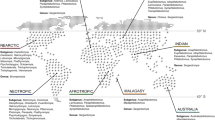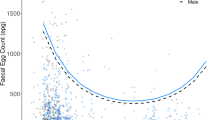Abstract
The fat-tailed jird, a small North African rodent with a distinctive club-shaped tail, is a convenient research subject and an emerging model for Old World leishmaniasis. The authors present the natural history and biology of the Egyptian fat-tailed jird and provide guidelines for the breeding and husbandry of this species on the basis of their experience raising a colony from wild stock in Cairo, Egypt. They also discuss the diseases they encountered in wild and captive-bred jirds.
This is a preview of subscription content, access via your institution
Access options
Subscribe to this journal
We are sorry, but there is no personal subscription option available for your country.
Buy this article
- Purchase on Springer Link
- Instant access to full article PDF
Prices may be subject to local taxes which are calculated during checkout








Similar content being viewed by others
References
Refinetti, R. Homeostatic and circadian control of body temperature in the fat-tailed gerbil. Comp. Biochem. Physiol. A Mol. Integr. Physiol. 119, 295–300 (1998).
Muller, M., Ott, H. & Bruns, V. Frequency representation and spiral ganglion cell density in the cochlea of the gerbil Pachyuromys duprasi. Hear. Res. 56, 191–196 (1991).
Plassmann, W. & Kadel, M. Low frequency sensitivity in a gerbilline rodent, Pachyuromys duprasi. Brain Behav. Evol. 115–116 (1991).
Muller, M. Quantitative comparison of frequency representation in the auditory brainstem nuclei of the gerbil, Pachyuromys duprasi. Exp. Brain Res. 81, 140–149 (1990).
Aschoff, A., Muller, M. & Ott, H. Origin of cochlea efferents in some gerbil species. A comparative anatomical study with fluorescent tracers. Exp. Brain Res. 71, 252–261 (1988).
Benazzou, T. et al. Chromosomal phylogeny of Gerbillidae. III. Species study of the genera Tatera, Taterillus, Psammomys and Pachyuromys. [French] Ann. Genet. 27, 17–21 (1984).
Eisenberg, J.F. & Isaac, D.E. The reproduction of heteromyid rodents in captivity. J. Mammal. 44, 61–67 (1963).
Héron-Royer, L.F. Concrétions vagino-utérines observées chez le Pachyuromys duprasi. [French] Zool. Anz. 4, 623–628 (1891).
Lataste, F. Sur le bouchon vaginal de Pachuyromys duprasi. [French] Zool. Anz. 5, 235–239 (1882).
Jäkel, T. Cyclic transmission of Sarcocystis gerbilliechis n. sp. by the Arabian saw-scaled viper, Echis coloratus, to rodents of the subfamily gerbillinae. J. Parasitol. 81, 626–631 (1995).
Hanafi, H.A., Kittell, C.E., Tobias, S.W. & Dykstra, E.A. Viability of the Fat-Tailed Jird, Pachyuromys duprasi natronensis (Rodentia: gerbillidae), as an Alternate Laboratory Model for Old World Leishmania Studies. 1st International Congress on Infectious and Tropical Diseases. Muscat Sultanate of Oman, 27–30 March 2000.
Osborn, D.J. & Helmy, I. The Contemporary Land Mammals of Egypt (Including Sinai) (Field Museum of Natural History, Chicago, 1980).
Hoath, R. A Field Guide to the Mammals of Egypt (The American Univ. in Cairo Press, Cairo, 2003).
Flower, S.S. Notes on the recent mammals of Egypt, with a list of the species recorded from that kingdom. Proc. Zool. Soc., Lond. 101, 368–450 (1932).
Robinson, D.G. Gerbil classification and nomenclature. The Gerbil Digest 2, 1–4 (1975).
Tortora D.F., Eyer J.C. & Overmann S.R. The effect of sand deprivation on sandbathing and marking in Mongolian gerbils (Meriones unguiculatus). Behav. Biol. 11, 403–407 (1974).
Fox, J.G., Anderson, L.C., Loew, F.M. & Quimby, F.W. (eds.) Laboratory Animal Medicine 2nd edn. (American, San Diego, 2002).
Ying, B., Kosoy, M.Y., Maupin, G.O., Tsuchiya, K.R. & Gage, K.L. Genetic and ecological characteristics of Bartonella communities in rodents in southern China. Am. J. Trop. Med. Hyg. 66, 622–627 (2001).
Acknowledgements
We thank Nivine Moawad and David Bentzel for their technical writing assistance. We also express our gratitude to the following NAMRU-3 Animal Resources Department personnel, past and present, who generously provided quality veterinary care to not only our FTJs but the rest of our housed animals: Animal Caretakers: Ibrahim Salem, Salah El-Sayed Ahmed and Mohamed Galal; Veterinary Technicians: Neil Domingo, Jimmy Howard, Willie Sifford, Rickey Claiborne, John Maguranis, Damien James, Aaron Boyles, Brett Long, Christopher Bell and Krista Spellum; and Veterinarians: Cornel Kittell, Stephen Tobias, Rebecca Holt, Mohamed Abdel Fattah and Fady Guirgiss. The opinions expressed in this paper are those of the authors and do not reflect the official policy of the Department of Navy, Department of Defense or the US Government.
Author information
Authors and Affiliations
Corresponding author
Ethics declarations
Competing interests
The authors declare no competing financial interests.
Rights and permissions
About this article
Cite this article
Felt, S., Hussein, H. & Mohamed Helmy, IH. Biology, breeding, husbandry and diseases of the captive Egyptian fat-tailed jird (Pachyuromys duprasi natronensis). Lab Anim 37, 256–261 (2008). https://doi.org/10.1038/laban0608-256
Received:
Accepted:
Issue Date:
DOI: https://doi.org/10.1038/laban0608-256
This article is cited by
-
Flexibility and rigidity in hunting behaviour in rodents: is there room for cognition?
Animal Cognition (2022)



